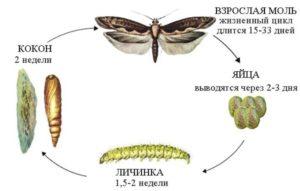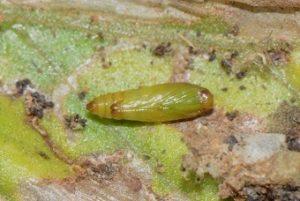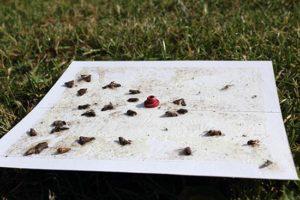Tomato moth: a pest that can destroy the crop
Content
The pest of nightshade crops, in particular, tomatoes, is the mining tomato moth, known to many gardeners Tuta absolute. If you do not fight, it can destroy the entire crop in a short period of time.
What does a tomato moth look like (photo)
Appearance and lifestyle
Name: Tomato Moth, Tomato Leaf Miner
Latin: Absolutely allClass: Insects - Insecta
Squad: Lepidoptera - Lepidoptera
Family: Notched-winged moths - Gelechiidae
 | Habitats: | garden |
 | Dangerous for: | nightshade crops |
 | Means of destruction: | chemical, biological and folk remedies, entomophages |

Tomato moth caterpillar.
Tomato miner moth parasitizes on tomatoes and other nightshade crops (eggplants, peppers, potatoes). This type of pest has penetrated other continents and countries: in Russia - it is found in the Adyghe Republic, Bashkiria, the Krasnodar Territory, in Europe - In Italy, France, Spain.
In length, an adult insect is from 5 to 7 mm, gray-brown in color. The forewings have dark spots, the hindwings are dark gray with scales.
Tomato moth larvae, when they first emerge from the egg, are yellow in color, in subsequent stages of development they take on a green color with a characteristic black stripe behind the head, and closer to the pupal stage, the shell becomes pink.
Butterflies are nocturnal, hiding in foliage or grass in the morning.
Life cycle and reproduction
A mature female can lay up to 300 eggs. Cream-colored oval eggs. After a week, larvae appear from them.
For further development, they need nutrients, caterpillars begin to gnaw through leaves, stems and unripe fruits. The characteristic dark spots appear on the leaves.
The period of development of larvae is from 10 to 36 days, depending on the ambient temperature. Tomato moth larvae show their activity at a temperature of +9°C. In the final stage of development, caterpillars leave their shelter, form a cocoon and turn into a chrysalis.
After about 10-12 days, the transformation process ends, and a butterfly flies out of the cocoon. The life span of an adult insect is from 10 to 25 days.
Under favorable climatic conditions, up to 12 generations of the pest can reproduce during the season.
What harm does tomato moth bring
Tomato moth larvae need nutrients to go through all stages of development, which they get from plant juices by eating leaves, stems and fruits.
Caterpillars damage the structure of the leaf, leading to its drying out, passages and dark spots on it are visually visible, as well as to a delay in the development of the entire plant. On fruits damaged by tomato moths, the core has been eaten away, which leads to damage by fungal diseases and rotting.
Cases of parasitism on deciduous trees have been noted. The moth mines shoots, young leaves, buds.
Pest control measures
Tomato moth control methods include several varieties:
- chemical
- Biological
- People's
- Mechanical
- Preventive.
Biologists and agricultural technicians have developed a set of measures to combat the mining tomato moth. This is the timely detection of pests and control over the number.
Use glue and pheromone traps. They also carry out thorough cleaning and destruction of infected crops, change planting sites and perform autumn plowing.
In winter, the premises of greenhouses are cooled down, this type of moth does not have a diapause and does not withstand cold and frost, the larvae hiding in the soil die.
Chemical methods
The ability of larvae to penetrate deep into leaves and stems complicates the fight against them. Therefore, agents are used that can seep into the plant. These include:
- You decide;
- Lannat;
- Deltamethrin;
- Actellic.
Since insecticides are poisonous, it is necessary to take precautions when working with them, use gloves and masks.
Folk remedies
Chemical treatment is considered aggressive and is carried out in cases of severe infection of plants. First, it is recommended to apply folk measures of struggle.
They include:
- Hanging on the site traps with a sticky layer of bright yellow color that attract insects.
- Watering bushes with water from a hose. A jet of water knocks down female butterflies and does not allow them to lay eggs.
- Collection and destruction of infected leaves and fruits.
- Visual inspection of plants, manual collection, destruction of caterpillars.

Moth damage to tomatoes.
- Spraying the bushes with an extract from neem seeds, which contains the substance azardiractin, which acts on the larvae.
- Treatment of bushes with mustard and rapeseed oil. This method negatively affects the respiratory system of the larvae, they become uncomfortable, and they leave the plant.
- Orange zest and essential oil, sprigs of lavender and mint are used as repellents (it is recommended to plant bushes of these plants between tomato beds).
Biological methods of struggle
As biological preparations, the bacterial composition of Bacillus thuringiensis and the fungus Metarhizium anisopliae are used, which destroy the digestive tract of larvae and butterflies and cause death.
Also becoming relevant are such means of control as pheromone traps for adult insects and the attraction of living organisms - natural enemies of the tomato moth.
Traps can reduce the population, but not completely eliminate the pests.
Alive organisms
Natural methods of dealing with tomato moths are to attract entomophages - insects that feed on their larvae and eggs. These are two types of bugs: nesidiocoris tenuis and macrolophus tais.
Adults and nymphs of this insect are voracious and capable of destroying the eggs of the South American tomato moth in a short period of time. But you need to be careful when breeding this beetle in a greenhouse, if there are not enough victims, it damages the plants.
Greenhouse protection
The methods of protecting greenhouses from tomato moths include measures to prevent the appearance and stop the reproduction of pests. Perform the following steps:
- Greenhouse crops before planting in the ground are kept in quarantine for at least 10 days.
- Seedlings are treated with infusion of chamomile or a weak solution of potassium permanganate.

- Insects are planted in greenhouses that feed on larvae and eggs of tomato moths.
- Greenhouses and soils are treated with aqueous chemical or biological solutions against moths.
- A fine-mesh net is placed on the ventilation windows and the entrance to the greenhouse to prevent pests from getting inside.
In cases of severe infection, the bushes are treated with insecticides.
Prevention of the appearance
Preventive methods include:
- Careful inspection of plants when buying in a store (an alternative is to grow seedlings yourself).
- Frequent control of leaves and fruits for the appearance of eggs and moth larvae and, if necessary, manual collection and destruction.
- Change of planting site.
Preventive measures prevent the problem of the appearance of a tomato pest.
Conclusion
The South American tomato moth can harm both young plants and fruits in the ripening stage. Therefore, it is necessary to fight it at the slightest sign of detection. If you follow preventive measures and timely destroy the larvae and the insects themselves, then the crop will be saved.
Previous





It is worth knowing that smoke treatment is very effective against tomato moths. In this case, insecticidal smoke bombs such as Quiet Evening, Whirlwind or City will fit very effectively. They destroy all pests with the help of their active substance - permethrin. So, after I smoked my greenhouse with these checkers, there was no tomato moth after that.